Incas

A man and a woman of the Inca race walk along one of the difficult roads built in the Andes. Ahead of him is a llama, used as a beast of burden. On the mountainside peasants are cultivating crops.
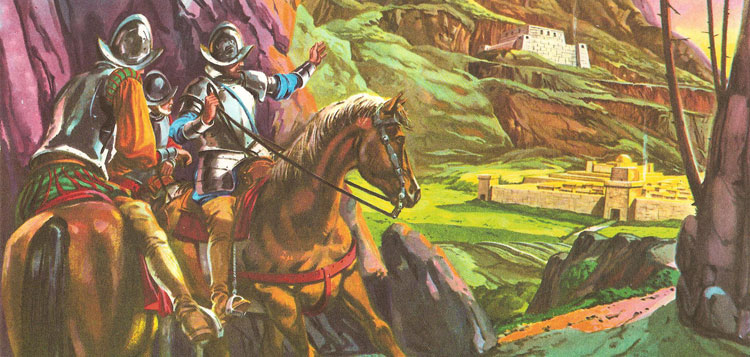
Three of Pizarro's Spanish horsemen come in view of Cuzco, the capitol of the Incas. (In the background is the colossal fortress which dominated the city.).
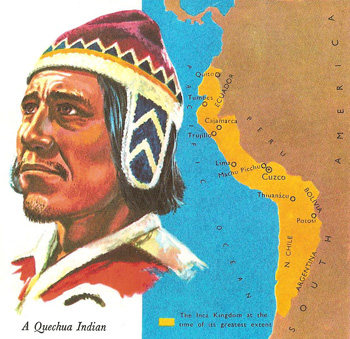
Quechua indian and map.
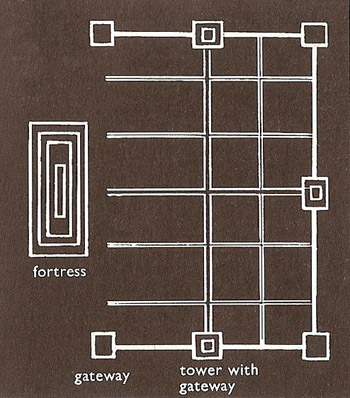
Plan of Cuzco in the time of the Incas. The city was divided into a number of districts bounded by straight streets which crossed each other at right angles.
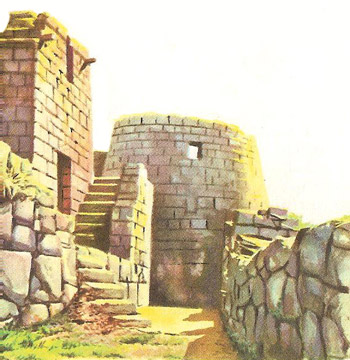
A street in Machu Picchu.
In 1511, when Vasco Nuñez de Balboa, the discoverer of the Pacific Ocean, was weighing some gold which he had collected from the natives of Panama, a young barbarian chieftain who was present struck the scales with his fist and, scattering the glittering metal around the apartment, exclaimed: 'If this is what you prize so much that you are willing to leave your distant homes and risk even life itself for it, I can tell you of a land where they eat and drink out of golden vessels, and gold is cheap as iron is with you.'
The conquest of Peru
It was not until 1531, however, that Captain Francisco Pizarro, recently appointed representative of King Charles V of Spain and accompanied by a force of 800 men and 27 horses, sailed in three ships with the intention of penetrating the mountainous and well-defended country of Peru, the Land of the Incas. The term 'Inca' is now used to describe the Indian tribes and their civilization as they were discovered by the Spaniards in Peru, Ecuador, Bolivia, and northern Chile.
The expedition disembarked near Tumbes on 13 May 1532, just as the Incas were concluding a devastating civil war. Atahualpa was now Inca, or emperor, elect, and he failed to realize the strength of these strange invaders.
Little resistance was offered to the Spaniards until they reached the inland town of Cajamarca, where they were surrounded by 50,000 Inca warriors. Here a meeting was arranged between the two leaders: Spanish treachery, combined with the use of guns and firearms, resulted in the massacre of 2,000 Peruvian guards 'unarmed so as not to give offence', and the capture of Atahualpa.
During the next five years the ancient empire was overrun by Spain, and treasure to the value of about 70 million pounds fell into the hands of the conquerors (known as Conquistadores), the Spanish Church, and the King of Spain.
The conquest of such a vast area by a handful of adventurers is one of the most extraordinary events of history. Why it lasted so long is accounted for by the fact that the empire was very well organized, with the authority cent red in the Inca. Thus on his removal and replacement by a Spanish Governor, administration and daily life continued for a long time along the old lines.
The Incas
The 'Sapa Inca' who dominated this enormous region was regarded by his Quechua Indian subjects as divinely descended from the Sun God. Land, people, earth, gold (the sweat of the sun), silver (the tears of the moon) were all his property. His duties included the protection of his people from war and famine, the upkeep of roads, and the maintenance of law and order. To aid him in these tasks he had hundreds of imperial officers. His head wife, or coya, reigned as queen and the Inca had the right to name the most capable of her sons as his successor. After death the royal corpse was mummified.
Architecture
The best known monuments of Inca architecture were constructed by the government from careful plans. The capitol city Cuzco lay in a broad valley and was divided into four parts according to the cardinal points of the compass, and had two central plazas. The houses of the ordinary townsfolk were one story high, but those of the wealthier citizens possessed two and sometimes three stories.
The main buildings were designed by professional architects and were marked out by long stretches of elaborately cut stone, squared and set with exceptional precision. The royal palaces and the Sun Temple were sheathed with gold plate. The most fabulous edifice in Cuzco was the Golden Enclosure (Curi-Cancha). This shrine had five sanctuaries dedicated to the sun, moon, stars, lightning, and rainbow respectively. A courtyard named the Field of the Sun encircled a gold fountain, and also 'a golden mimicry of plants', which included an artificial cornfield, and full-size golden models of llamas, with golden shepherds to watch over them.
The fortress, or pucara, known as Sacsahuaman, standing on a hill behind the city, was built of stone blocks, some of which weighed 20 tons. They were carved by craftsmen using stone tools, lifted by bronze levers, and transported from the quarries on rollers by man-power. Its construction took 30,000 workers 70 years to complete.
The road system
In order to maintain communications throughout the great length of the Inca realm it was necessary to have an efficient network of roads. More than 1,000 miles of all-weather highways were created, the main ones being the 'Royal Road' (Capacnan) which crossed the Andes highlands through modern Ecuador, Peru, Bolivia, and continued into Argentina; and the Coastal road which ran from the frontier at Tumbes into Chile. The former was 3,250 miles long, and the latter was 2,520 miles. They were connected by transverse roads.
Arterial roads were of a standard width of 24 feet, but as the wheel was unknown they were not intended for vehicular traffic. Cliffs were surmounted by stone steps; rivers spanned by suspension bridges made of fibre cables and referred to as 'the little brothers of the road'; marshes were crossed by earthen causeways paved with stone slabs; and hills were occasionally pierced by tunnels. Side walls to keep out sand drift and to mark kerbs were a unique feature of the Peruvian roads.
At regular intervals rest-houses, or tambus, were built for the use of state officials on tour, and distances were recorded on milestones. Pack trains of llamas were used for the transport of goods, while important people were carried on litters. Along these roads a relay system of couriers conveyed the Inca's messages and reports to and from every part of the Empire.
When the ruler visited the provinces he traveled in great majesty seated in a magnificent, curtained palanquin enriched with gold and silver. He was escorted by the Royal Guard, and preceded by 5,000 men armed with slings. Eighty litter-bearers took it in turns to shoulder the burden.
Agriculture
Agriculture was the life-blood of the Inca Empire and largely depended on the herding of llamas as beasts of burden and on alpacas and vicunas, both much prized for their fine wool. Guinea pigs, or cuy, provided the staple meat food.
Much of what the world eats today was developed by the farmers of Peru. Many varieties of potatoes and maize, as well as beans (particularly cacao), tomatoes, pineapples, strawberries, blackberries, pumpkins, and cucumbers were but a few of the plants cultivated by communal efforts of the Incas.
As the amount of flat land in Peru is very limited, the sides of the valleys were terraced for cultivation. All arable land was kept fertile by a superb system of irrigation, the stone-built reservoirs of which also supplied water to the cities.
The ground was tilled by a foot plough or tacila, while women broke the earth clods with a hoe or lampa. The fields were often manured with guano (bird droppings) brought up from the coast. In due season, state land was both ploughed and harvested first. This was regarded as labor service, after which the peasants were free to help each other on their own holdings.
The Quipu
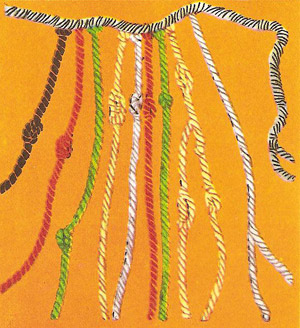 |
In spite of the Peruvians' considerable achievements in almost every form of culture they never invented any system of writing. The Quipu was a device to aid memory, but it had to be accompanied by verbal comment for its meaning to be understood. It consisted of a main cord (ranging from one foot upwards in length), and from which this dangled smaller colored strings which had knots tied in them at intervals to represent numbers. These were indicated according to their position and their distance from the beginning of the string. Cords of different colors referred to definite objects. Historians (Rememberers) and accountants were trained and appointed to the special custody of Quipus, and by this method the history of the Inca race was recorded and handed down from generation to generation. The Spanish priests regarded these archives as 'books of the devil', and their ruthless destruction was an historical disaster.
